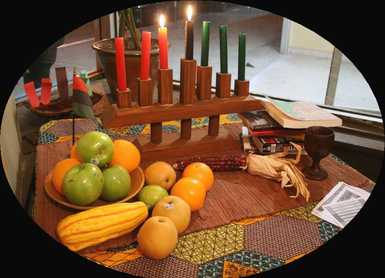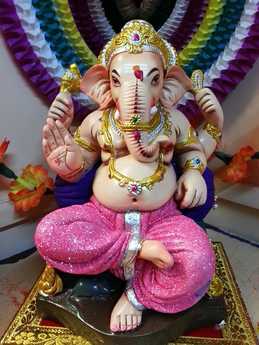 When I was a kid, this time of year was about one thing only: Christmas. All Christmas, all the time. Decorating the tree with ornaments that were comforting in their familiarity; writing detailed missives to Santa; visiting John A. Brown department store in Oklahoma City to ogle the dolls, trains and games; sitting on Santa's lap and refreshing his memory about the contents of that letter I'd sent him.  I wasn't the only one who got swept up in the holiday spirit. My parents did Christmas big. They crafted candles that looked like snowballs, whipped up batch after batch of cookies, fudge and divinity (a confection that belied its name, as far as I was concerned—I never could stand the stuff) and filled nearly every horizontal surface in the house with elves, reindeer, sleighs, crèches, holly and other icons of the season.  Definitely not my dad's decorations! Definitely not my dad's decorations! Then there were the outdoor decorations, my dad's territory. His was no blow-out-the circuits Griswold family Christmas display; his style was more subtle, with tiny white lights outlining the bay window, topiary flanking the front door, ribbon candy-striping the lamp post, and candles floating on poinsettia-shaped rafts in the courtyard fountain. One year his artistry even won the city-wide house decoration contest, besting showier arrays with rooftop Santas and plywood carolers.  Kwanzaa altar Kwanzaa altar Everyone we knew celebrated Christmas much as we did, except for the one Jewish family in the neighborhood, and even they engaged in some Christmas customs. But as the years went on and my world expanded, I met people who celebrated Yule, Kwanzaa and other holidays at this time of year. Everything I learned about their rituals enriched my appreciation of the season. Recently, I learned about still more traditions from—of all places—a mail-order catalog that had descriptions of winter celebrations from many cultures sprinkled among its product offerings. In the spirit of giving, I'd like to share a few tidbits about some of the special days that captured my attention.  Bodhi Day—December 8 On this occasion, Buddhists commemorate the day when Siddhartha Gautama, sitting under the Bodhi Tree, attained enlightenment and became the Buddha or "Awakened One." Buddhists consider Bodhi Day a time to renew their dedication to wisdom, compassion and kindness, keystones of their spiritual path. They celebrate with meditation, chanting and performing acts of kindness.  Winter Solstice—December 21 In prosaic terms, winter solstice is an astronomical phenomenon marked by the shortest day and longest night of the year. In the Northern Hemisphere, this happens in December; in the Southern Hemisphere, in June. But since ancient times, people have attributed deeper significance to this event. While interpretations vary, many cultures consider it a time of rebirth and new beginnings—an opportunity to examine the deeper parts of one's being, to reflect on untapped potential and bring it into the light. Among the many celebrations that coincide with winter solstice are these: 


 Pancha Ganapati—December 21-25 This modern Hindu festival honors Ganesha, lord of success and remover of obstacles. The festival focuses on mending past mistakes and making a new beginning. Each day, the whole family engages in a different sadhana or daily spiritual practice, centered on creating love and harmony in relationships or in the world. A statue of Ganesha is placed in a shrine in the living room, and children dress or decorate it each day in different colors representing Ganesha's five powers or shaktis.  As I read about these observances and consider what we can learn from each of them, I notice not only their rich diversity, but also their common threads. No matter what or how we celebrate, there's value in taking time out to gather with people we love, to share stories and wisdom, to reflect on days gone by and days to come, and to rededicate ourselves to kindness, compassion, love and harmony. Some information in this post came from:
"Celebrating Bodhi Day for the 21st Century," by Lewis Richmond, The Huffington Post "Soyal Ceremony: Hopi Kachinas Dance at Winter Solstice," by Jack Eidt, WilderUtopia "Celebrating Yalda Night," by Firouzeh Mirrazavi, Iran Review
9 Comments
Nan
12/21/2016 08:09:33 am
Wasn't it an absolute wonderland? All the decorations and the elevators and interesting things to see. I remember the candy counter with the giant, swirly lollipops. I always wanted one of those. I think I finally got one and it was kind of disappointing.
Reply
12/21/2016 08:40:22 am
Wonderful festive post, and as usual you stirred up memories of warm, sweet smelling kitchens, laughter, family, friends, and good cheer. Merry Christmas, Nan.
Reply
Nan
12/22/2016 04:27:58 pm
Thanks and Merry Christmas to you, too, Susan!
Reply
Tonya Howe
12/21/2016 09:47:38 am
Nan, I appreciate your gift of reserch. The chunks of information that you offered certainly satisfies some of my curiosity concerning traditions of other cultures. I'm going to share these stories w/grandaughter and niece. I've seen the little elephant figurine and wondered what it symbolized. (I like it's meaning)
Reply
Nan
12/22/2016 04:29:26 pm
I love hearing that you're going to share the stories of other traditions with your young family members. Happy Holidays!
Reply
Emily Everett
12/21/2016 06:52:33 pm
How fun to read about your Christmas memories and also to see how people in other parts of our world celebrate in the winter. Great blog. (Ganesh is still ugly :)
Reply
Nan
12/22/2016 04:31:34 pm
You may think Ganesh is ugly, but you've got to admit he's working those pink pants!
Reply
Leave a Reply. |
Written from the heart,
from the heart of the woods Read the introduction to HeartWood here.
Available now!Author
Nan Sanders Pokerwinski, a former journalist, writes memoir and personal essays, makes collages and likes to play outside. She lives in West Michigan with her husband, Ray. Archives
April 2022
Categories
All
|


 RSS Feed
RSS Feed